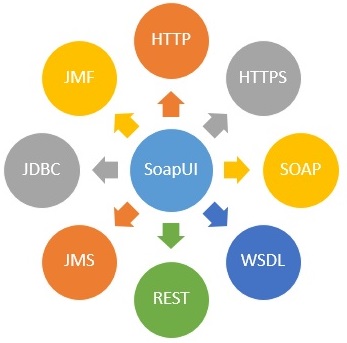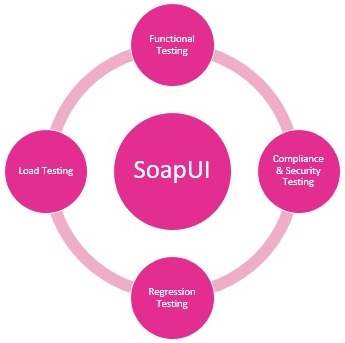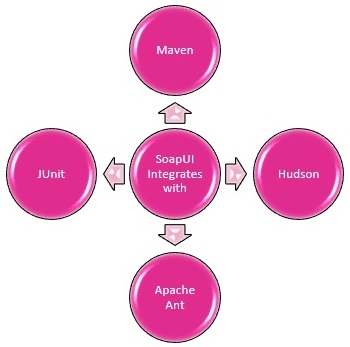Hello STC readers, hope you are doing good. Since long back we are receiving multiple requests for article on SoapUI web service testing tool. Today we are posting Full Series on SoapUI Tutorial For Beginners. Introduction to SoapUI tutorial series is designed specially for beginners to learn SoapUI from scratch. We are covering following topics in this tutorial:
——————————————————————————————
SoapUI Tutorial For Beginners

——————————————————————————————
Syllabus:
Tutorial 1 – Introduction to SoapUI – Why SoapUI?
Tutorial 2 – What is Web Service and How it is tested?
Tutorial 3 – Web Service Sample Project and its Testing
Tutorial 4 – Installation and configuration of SoapUI
Tutorial 5 – Your First SoapUI Project
Tutorial 6 – How to do Functional Testing in SoapUI?
Tutorial 7 – Simple guide to create Load Testing using SoapUI
Tutorial 8 – Mock Services Testing in SoapUI
Tutorial 9 – How To Perform Security Testing In SoapUI?
Tutorial 10 – REST Testing using SoapUI
Tutorial 11 – REST Sample Project
Tutorial 12 – Sample Web API Project Testing Using SoapUI
Tutorial 13 – Schema Inference
Tutorial 14 – 10 Testing Tips for the SoapUI Beginners
——————————————————————————————
Tutorial 1 – Introduction to SoapUI – Why SoapUI?
SOAP stands for Simple Object Access Protocol. It is a protocol which is used to exchange information in the form of structured data like XML, JSON or plain data etc. with the help of Web Services or Web API in computer networks. XML format information is negotiated and transferred on the application layer of computer networks using protocol like HTTP (Hyper Text Transfer Protocol), SMTP (Simple Mail Transfer Protocol) etc.
So far we have discussed about only SOAP protocol, now let’s understand SoapUI.
- SoapUI is an open-source testing tool which can operate in cross-platforms.
- It is mainly used to test Web services and Web APIs.
- It has very simple User Interface which is very easy to handle by both technical and non-technical users.
- It is capable to test application based on both representational state transfers (REST) and service-oriented architectures (SOA).
- Using SoapUI tool, tester can automate both functional tests as well non-functional tests and can execute compliance, regression, security and load tests for Web APIs.
- All standard protocols like HTTP, HTTPS, SOAP, WSDL, REST, AMF, JDBC, JMS, etc. are supported by SoapUI and has in-built technologies to test all kind of APIs. Diagram below represents the protocols supported by SoapUI.

Protocol testing support by SoapUI tool
Why SoapUI?
I have put the title as “why SoapUI?” so as to illustrate the importance of SoapUI as a tool in testing domain. In an application where there are web services or web APIs, SoapUI tool is a boon to testers as it helps to cover both functional as well as non-functional tests with no hassles as its user interface is very simple to use. Using SoapUI, we can do following type of testing for web services and web APIs, we will discuss the differences between web services and web APIs later.
1. Functional or Behavioral Testing:
As we know in functional testing we covers the functional or behavioral testing aspects of the web services and web APIs. Using SoapUI the tester can leverage below features:
- Drag and Drop: This the best feature for new testers to build the test automation by simply using drag and drop feature of SoapUI. This accelerates the development of scripts for test automation.
- Custom Scripts: Depending on the functional test scenarios, SoapUI supports advance scripting option which help in writing the custom scripts for tests automation scripts development. This offers flexibility of writing scripts within the tool.
- Hassel Free Environment Switching: It is easy to switch and test web API code between different environments like UAT (User Acceptance Test), QA (Quality Assurance), SIT (System Integration), etc.
- Test Debugging: SoapUI tool helps tester to debug their test scripts and permits to write data driven tests. Tester may put various check points to verify that their test is getting executed as expected.
- Robust Tool: No doubt, depending on the above mentioned capability of the SoapUI tool and its robustness in writing the test automation scripts. It makes a robust testing tool to test Web service and Web APIs in any software application.
2. Compliance Testing:
Using SoapUI tool, the tester can validate the compliance tests and can automate it using tests scripts. Compliance tests mainly involves the source and its data authentication using licence certificates, etc. and various service level agreements before and after calling the web services or web APIs within a software application.
3. Regression Testing:
Regression testing is conducted to analyze any defect or malfunctioning introduced within the web services after new change is implemented with the current release or in simple words, it is used to find any side effects of the new change or fix. Tester can execute the test suits to ensure existing functionalities are not breaking and new change is right in place using SoapUI tool.
4. Load Testing:
Load testing is conducted to analyze the load that a web service or web API can withhold before it breaks. Let’s discuss the features that SoapUI supports as follows:
- LoadUI Agents: SoapUI has number of LoadUI agents over which load can be distributed and can analyze the various performance parameters.
- Ease of Use: Leveraging the simple user interface and handling LoadUI agents of SoapUI tool, load testing becomes very simple and easy to operate.
- Performance Monitoring: SoapUI has advance reporting system to capture various performance parameters for load testing. Also it permits performance monitoring for end-to-end system load testing.
5. Security Testing:
This kind of testing is supported by SoapUI to ensure authorization and authentically in request and response model of web services and web APIs. Let’s take a look on the features that SoapUI supports as follows:
- Cross Site Scripting: It scans and detects for any exposure of service parameters in the structured messages during cross site scripting.
- Securing Database: It scans and detects for any potential SQL injections that could harm database, thus securing database.
- Stack Overflow: SoapUI has the capability to scan and detect for huge documents within the message that could cause stack overflow.
- Lifesaving Scans: SoapUI has the capability to do number of scans and ensures the security of the web services and wen APIs. These scans are vulnerability scans, fuzzing scans and boundary scans to mitigate the potential erratic behaviour of the web services.

Testing support by SoapUI tool
SoapUI Integration:
SoapUI tool can be used in collaboration with number of popular building tools as follows:
- Apache Ant: Apache ant uses the command line for building projects. Similarly, it can use SoapUI command line to execute the test suites.
- Hudson: Hudson is an integration tool built on JAVA platform. By integrating SoapUI with Hudson, it has the benefit to discover bugs very early on the click of every commit of code from development team.
- Maven: Maven is a project management automation tool which is mainly used to build JAVA projects. It has capability to automate the build, version control and documentation from a central repository. Using Maven build, we can also build and execute SoapUI tests following number of simple commands.
- JUnit: JUnit is the unit testing framework built on JAVA which can be integrated with SoapUI tool to do the unit testing for web services and web APIs as well.

SoapUI Integration support
Comparison of SoapUI with other Testing tools (Fitnesse and Selenium):
| Properties | SoapUI Tool | Fitnesse Tool | Selenium Tool |
| Testing Type | SoapUI tool is used to test functional, compliance, regression, load and security testing. | Fitnesse tool is used for user acceptance tests. It also helps in executing functional tests as well as regressions. | Selenium is used to website testing covering functional and regression tests. |
| User Interface testing | SoapUI is not a testing tool to test user interfaces (UI). | It is not used to test Web user interfaces. However can be collaborated with Selenium tool to do such testing. | It is primarily used to test web user interface (UI) testing. |
| Web Services and Web API testing | It is primarily used to test Web Services and Web APIs. | It can be integrated with SoapUI and collaborate to test Web APIs and Web services | It is not used to test Web APIs and web services. |
| Protocol Testing like SOAP, REST, etc. | SoapUI can be used to test data transferred to and received from, between web servers and client browsers thus can tests protocol like SOAP, REST, etc. | Fitnesse can validate the data sent and received between web servers and browser but cannot test protocols like SOAP, REST, etc. | Selenium can test the data sent and received between web server and client browser through UI testing, however it cannot test for protocols like SOAP, REST, etc. |
| Non-functional testing like Performance, load, compliance and Security testing | SoapUI tool supports LoadUI agents which extends capabilities to do performance and load testing. Also with the help of number of scans like vulnerability, fuzzing and boundary scans, etc. it helps to conduct security as well as compliance testing. | Fitnesse do not support performance, security and load testing. For compliance testing it can be used to validate the data between the client and server. | Selenium is mainly used to do functional testing. However selenium can be used to do performance testing to some extents as it helps in tracking execution time but cannot test multi user and multi tenancy. Selenium cannot be used for security testing at all. |
| Testing Dependency | SoapUI testing depends on Protocols like HTTP, SOAP, WSDL, REST, etc. No dependency on browser. | Fitnesse is mainly used to validate the data sent and persisted in database which is kind of user acceptance testing. It neither depends on protocol nor web browsers. | Selenium testing depends on Web browser but not on protocols like SOAP, WSDL, REST, etc. |
Abbreviations Used:
| Abbreviations | Full Form |
| SOAP | Simple Object Access Protocol |
| HTTP | Hyper Text Transmission Protocol |
| HTTPS | Hyper Text Transmission Protocol Secured |
| WSDL | Web Service Definition Language |
| REST | Representational State Transfer |
| AMF | Action Message Format |
| JDBC | Java Database Connectivity |
| JMS | Java Messaging Service |
| WSDL | Web service Definition Language |
Conclusion:
Today we kicked off the full series of “SoapUI Tutorial For Beginners”. In first article Introduction to SoapUI we covered following points:
- We understood about what is SoapUI and why SoapUI used.
- Different Protocol testing supported by SoapUI tool.
- Type of Testing supported by SoapUI tool.
- Illustrated the importance of SoapUI as a tool in testing domain.
- Integration of SoapUI tool with different popular tools.
- Comparison of SoapUI with Fitnesse and Selenium testing tools.
Next tutorial >> Tutorial 2 – What is Web Service and How it is tested?
⇓ Subscribe Us ⇓
If you are not regular reader of this website then highly recommends you to Sign up for our free email newsletter!! Sign up just providing your email address below:
Happy Testing!!!
- Create Your First SoapUI Project – Step By Step Guide
- What Is Web Service? How It Is Tested?
- Web Service Sample Project & Testing
- Installation and Configuration of Soap UI – Complete Guide
- Simple Guide To Create Load Testing Using SoapUI
- Mock Services Testing Using SoapUI
- How To Do Security Testing Using SoapUI?
- How To Do Functional Testing In SoapUI?
- REST Testing using SoapUI
- API Testing with Postman and Postman Alternatives


13 thoughts on “SoapUI Tutorial For Beginners [Full Series] – Introduction to SoapUI – Why SoapUI?”
Hello STC,
I am looking forward to learn SoapUI testing tool. You and your team is doing great work here. i am always referring my friends to refer this website. In two weeks back I started working on SoapUI web-service testing in my project.
This is really great you are publishing this beginner level SoapUI tutorial series.
Waiting for next article.
Thanks,
Ram
STC is really good platform to learn new things, especially learning for beginners.
Hello Admin,
I was looking for this since long back. I gone through first article and I am excited to read upcoming articles. I have subscribed to your Subscription. Please send me more detail over this tutorial.
Before closing this I am thankful to STC admin for such a wonderful series.
Thanks,
Ranjeet
Comprehensive list of chapters covered here. I guess tutorial is especially designed considering the freshers to start learning of SoapUI testing tool. We are waiting for next articles soon.
Thanks you very much.
@Ajit, As per my knowledge it is providing UI to test the Webservices with using SOAP protocol. If there is no UI for this then you must have been tested your webservices using some custom driver scripts.
I am fresher, as per my knowledge SoapUI testing tool is a tool which is used to test web-services. So why it is called ‘UI’ as we are not testing any specific UI.
Looking at the nice list of topics covered in the syllsybus I am excited about learning SoapUI tutorial for beginner. I am glad to see your first article on SoapUI. Simply great, much appreciated your efforts.
@STC team, you are doing a fantastic job here, you are helping testing community to growing up more freshers and shapping up many experience candidate like me.
Thanks,
Akshay
Hi Team STC, I am appreaciating your team work here. you guys doing a fantastic job to sharing information on testing era.
Hi,
I am a new to SoapUI. In my company I am working on website application where application deployed on tomcat server CentOS. Can we install SoapUI on Linux machine. If yes then please tell me how to install this.
Thanks in advance.
Hi,
I am working in manual testing. My manager ask me to work on WSDL testing. Can you please tell me what is WSDL and how to work on this?
Thanks for very good article, this is really nice tutorial for fresher to Web Services Testing.
The tutorial series first article is very informative. awesome work.
In the beginning of article STC admin said request from many readers, I am one of the reader who was asking and waiting for this tutorial series.